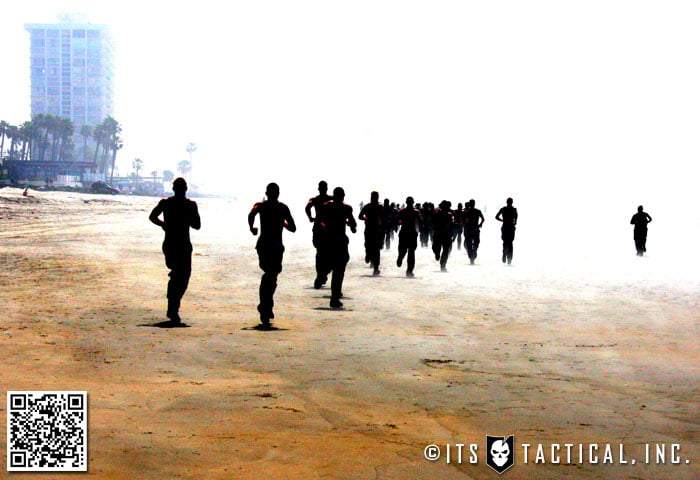How to Train for Running When You Have a Life
How to Train for Running When You Have a Life
 Let me start off by throwing in a caveat, I’m not an elite runner.
Let me start off by throwing in a caveat, I’m not an elite runner.
I never ran in high school or college, nor am I truly any type of physiologist or scientist.
I have however, over the past few years, taken a bigger interest in running, combined it with my longstanding interest in learning about human performance, and believe that I have learned a few things along the way that I can share.
Not everything that I’ve learned has come from pure trial and error. I learned once that if you want to succeed faster at something, find a role model who has done what you want to achieve.
That being said, a great deal of what I’ve learned in the past year has come from the help of a running coach, who I will freely give credit to in this article.
I am not a pure runner and I have other training goals such as weight lifting, PT and swimming (which I am not currently doing due to deployment).
Like any triathlete or multi-sport athlete, I have to balance different training disciplines, and it takes some planning.
When back in the civilian world, I also like to enjoy my social life and lets face it, there are just some other things that take precedence in life.
The First Step
The first step is outlining some basic training principles. These are not hard and fast principles, but they have worked for me and perhaps will help you in outlining your weekly training. The great thing about principles is that they provide flexibility in training organization.
One fairly accepted training principal for running is the need to include three key-days throughout the week. These three days typically include a day of intervals, a tempo run and a long run.
If you are able to, easy runs in between these days will only help to build volume, enhance aerobic capacity and when necessary and done right, actually facilitate recovery.
Lets look at a way to lay out a weekly training plan based on these principles:
- Monday – Long Run
- Wednesday – Intervals
- Saturday – Tempo Run or a Race
- In the case of a Sat race, it’s advisable to cut the amount of speed work on the preceding interval day by up to half, but keep the overall mileage the same
Just three days a week and you’re covering the development of a number of physiological aspects in running development. Again, if you seek further development of your running, just run easy days in between for further progress.
You can easily change your running days to adjust to a changing schedule too. For example, schedule a Sunday long run, use Tuesday for your interval day, and Friday for the tempo run.
For the multi-sport athlete, simply add in your strength training, etc. on Mon/Wed/Sat for example.
A Step Further
If your training goals include taking it a step further, even more flexibility in training organization is needed.
This really hit me last fall as I was beginning to train for a selection program. I needed to get in more swim time along with PT/strength training, but I didn’t want to let my running volume or performance slip.
The Monday long run was just a bit too much and fitting everything in became very stressful. I didn’t want to do it on Sunday, because I like to have some fun on Saturday nights, and you know the saying about all work and no play.
My three key days were now becoming too much of a strain. It was the stress of worrying about whether or not I would be able to get in all of my training, or worrying about whether something might come up.
Lets face it, distractions and life in general “happens,” and I wanted to try to eliminate this worry as much as possible.
A Great Idea
While reading an article on The Run Zone, my running coach Tom Schwartz’s Web site, I came upon the idea of two “Big Workouts” per week. At first I wasn’t certain if I was interpreting it right, but after picking his brain, I realized I was reading it right.
Schwartz explained that his friend Mike only did two Big Workouts per week. These included warm-up, speed-work and cool-downs and were approximately 15 miles of total running. All his other training days were easy five mile runs.
Suddenly I saw the advantage, by shifting the extra running volume from what used to be my stand-alone long run day, I only had to schedule two “Big Workouts,” or quality sessions.
The greatest thing I received in return was even more flexibility in planning my training. It all seemed to fit into the larger scheme of the psychology of why many of us train.
I believe that many of us like to train to be prepared for a little bit of everything. Why not have a training program that’s also prepared for a little bit of everything.
To refocus, it was the flexibility I gained without the drop in overall mileage that really helped. I was able to adjust my schedule on the fly during the week with much less stress (Training can be a stress even when you are not in the process of actually training.)
The Schedule
I found I was able to get in those Big Workouts on a Tuesday/Saturday, Tuesday/Friday or Wednesday/Saturday, with easy running days in between.
Perhaps the only caveat you’ll see in the recommended scheduling is allowing two full days sandwiched in between those Big Workout days. This schedule, for my goals, has been huge for me.
Since I deployed, although my mileage is down some, the same principles have helped me maintain my running fitness despite the dynamic and tiring schedule I’m currently on.
My Big Workouts are typically 12 miles total with warm-up/cool-down and three mile easy-runs on days in between. Before deploying, I was typically logging 13.5 miles total for the Big Workouts and five miles easy on the days in between.
One thing to note in the proposed scheduling is that there are only two “fast” or quality sessions. Some people refer to days of running as “hard/easy,” but I prefer to think fast/easy.
Realizations
The more I have read and learned, combined with personal experience and Schwartz’s recommendation, three fast-days per week are not necessarily required to progress.
This is also something that I noticed years back when I was first learning about running. I thought that if two interval days per week were good, that three must be better. That was not necessarily the case.
I remember a conversation with one of the first runners I idolized, after meeting him a few years back.
He had other physical pursuits/goals and believed in low-volume running, but he also instinctually based his training on an interval day, hill intervals, and a long run (Now at age 52, this guy still runs in the mid-18s for a 5K).
The common denominator again was two fast sessions per week. Keep in mind that even though they are “fast” runs or “fast” workouts, as I prefer to think, they are physiologically “harder” on the body and should be recognized as such.
As a side note, my use of the word “fast” is based upon the realization that I like running “fast,” not “hard.” It’s a mental trick, but it helps me relax when running “fast” and I tend to enjoy it more.
Adjustable Shelving
Another benefit to this type of scheduling is if you dread long steady-state runs, the Big Workouts are your long runs, but the speed work contained in them breaks up the monotony.
I can’t speak for everyone, but I usually enjoy a long run more when I know I will get to do some fast running. However, if you are human, there will be days where you might find that you need a rest, and a long, easier steady-state run will provide that.
I’m aware that this might not be an optimal schedule for everyone, but as my coach has mentioned a number of times on his Web site, a person can go from this base schedule and then add in as much extra easier-running as one can handle or cares to handle, to help raise performance.
The extra mileage, should you pursue it, could come from doubling up on your runs in a day, or lengthening the easy-day runs. In visualizing the big overall picture, just think of your week as an adjustable shelving unit.
The Big Workouts are the main shelves that you can take in and out, and rearrange when need be. But they also provide the framework on which to base the rest of your training around.
For a multi-sport athlete, such as a triathlete, when you have to account for the lower-body stresses from cycling workouts, just make one of the Big Workout days a long easy run to accommodate a hard bike session (I can’t take complete ownership of this idea as I believe I’d read that Triathlete Peter Reid arranged his training in a similar manner).
Tuesday was a running interval session for Reid and Friday was a fast/hard bike session. The point here, if I remember correctly, is that he was only putting in a total of two quality lower-body based sessions per week.
For the athlete that likes to run and strength train, you will have to decide which sport you wish to focus on most. If running is your main sport, but you want to continue to lift and train your lower body, it might be advisable to do your lower-body weight training on the same days that you do your fast running (perhaps a few hours after).
This will allow more recovery time in terms of days in between those quality sessions.
Closing Remarks
The schedule I’ve progressed to might not be the most optimal of training schedules, but it has been said that “success leaves clues,” and when I read that a 31 minute 10K runner was able to make progress using the principals of two Big Workouts that was enough proof for me.
Sometimes all it takes for a program to be successful, is belief in your program. It not only fits my needs for flexibility and enjoyment, but also allows for continued progression.
This isn’t intended to be a shameless plug, but it is a shameless mention of my coach, Tom Schwartz, and his experience. I would highly recommend you check out his Web site, TheRunZone.com.
There are a number of things that I didn’t cover, but in the context of the overall picture, I’m trying to keep in mind the 80/20 principle. The Big Workouts and filler runs in between are your 20 percent, which will give you 80 percent of your development and success (and quite possibly more than that, but we’re not touching on stretching, nutrition, recovery, etc.)
In the mean time, whether you’re training, running or working towards another mental and physical pursuit, perhaps this will help inspire you.
Keep searching and thinking outside the box so you can enjoy your training, your other pursuits and your life.
Boxer is currently deployed with the U.S. Navy and is a frequent contributor to ITS Tactical.











Discussion